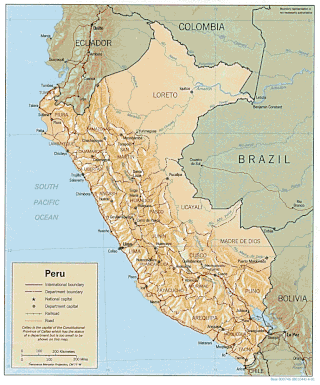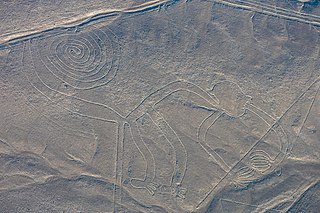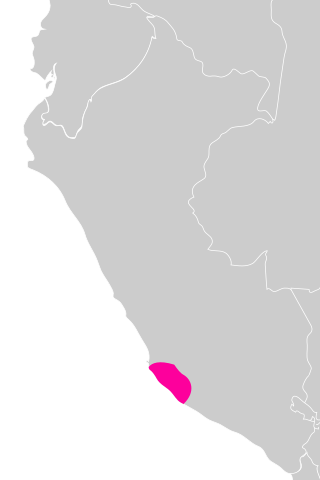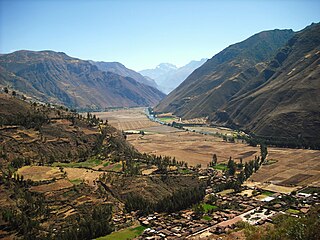Description
Huayuri is located about 80 kilometres (50 mi) from the Pacific Ocean at an elevation of 500 metres (1,600 ft) in Santa Cruz District of Palpa Province in the Ica Region of Peru. The nearby Santa Cruz River is a tributary of the Rio Grande de Nazca River, the basin of which had been occupied for thousands of years by earlier cultures such as the Paracas and Nazca. A successor to those earlier desert cultures, the culture of Huayuri is called the Poroma by archaeologists. The ruins of Huayuri extend along a ravine between two flanking ridges for about 500 metres (1,600 ft) with a maximum width of the densely settled area of about 175 metres (574 ft). The ruins have an area of 7 hectares (17 acres). The entire site, including the terraced slopes which flank the ravine, has an area of about 20 hectares (49 acres). [1] Among the ruins of dwellings are also enclosed compounds and storage facilities. [2]
The ruins of Huayuri overlook the valley of the Santa Cruz River at a distance of about 1 kilometre (0.62 miles). The river valley is narrow in the immediate vicinity of Huayuri, but about a kilometer wide a few 100 metres (330 feet) upstream. The river is dry most of the year, partially due to the use of its water for irrigation. [3] [4] [5]
The stone houses of Huayuri suggest that the inhabitants may have originated in the highlands because the coastal people of Peru customarily built in adobe while highland peoples built in stone. [6] The location also suggests that the inhabitants wanted a defensible place to live and thus the settlement was located in a ravine, rather than in the nearby valley of the Santa Cruz River with its limited but more abundant water supply and cultivatable land. Huayuri was located along the north–south Inca road (which probably pre-dated the Incas) leading from the extensive irrigated lands of Ica to Nazca. Archaeologists have found evidence that llama caravans visited Huayuri during Inca times, although the llama is better adapted to higher elevations than the coastal desert. [8]
Climate change and rainfall harvesting
The desert coasts of southern Peru and northern Chile are extremely dry. Nazca, the nearest sizeable city to Huayuri, receives less than 25 millimetres (0.98 in) of precipitation annually [9] and the region is nearly devoid of vegetation, except in river valleys and where irrigation is possible. Archaeologists, however, have found evidence that the climate was less arid in the Late Intermediate Period in which Huayuri flourished.
Geoarchaeological evidence points to a climate of the Huayari region during the Late Intermediate Period, with annual precipitation between 100 millimetres (3.9 in) to 200 millimetres (7.9 in). The higher precipitation permitted rainfall harvesting at Huayuri. For rainfall harvesting to be practical, there must be rainfall—which in later centuries is almost totally absent at Huayuri—and it must be fairly reliable. At Huayuri, a substantial infrastructure for harvesting rainfall is present. The water harvesting system at Huayuri was similar to the Khadin System used in the Thar Desert of India, as well as other locations around the world in dryland areas. The catchment area for water was the rocky upland around the settled area. Terraces were built into the hillsides and captured some rainfall. Additional water was captured and directed through channels and irrigation canals downhill onto a valley plain, enclosed at its bottom end by a bund or low dam. The captured water, its downhill path blocked by the bund, sank into the soil. Crops were planted in the area behind the bund without any additional irrigation. The soil was fertile because it was constantly renewed as the water deposited sediment and at the same time washed away harmful salts. Above and below the bund, rock-lined cisterns captured and preserved water which percolated down through the soil and was used for drinking and domestic use. [11]
The importance of rainfall harvesting at Huayuri indicates climate change in the Peruvian desert and that the Late Intermediate Period received greater precipitation than the historic era after the Spanish conquest beginning in 1532. However, rainfall harvesting could not create enough agricultural land to sustain a large population. The catchment area for rainfall harvesting is 15 to 25 times larger than the land that can be rendered suitable for agricultural areas. Rainfall harvesting provided only 2.5 hectares (6.2 acres) of agricultural land, plus drinking water, to the inhabitants of Huayuri. Assuming that the population of Huayuri was as large as the extensive ruins indicate, most of the food for the population came from irrigated agriculture in the adjacent valley of the Santa Clara River or was imported from elsewhere. [13]

Peru is a country on the central western coast of South America facing the Pacific Ocean. It lies wholly in the Southern Hemisphere, its northernmost extreme reaching to 1.8 minutes of latitude or about 3.3 kilometres (2.1 mi) south of the equator. Peru shares land borders with Ecuador, Colombia, Brazil, Bolivia, and Chile, with its longest land border shared with Brazil.

The Nazca Lines are a group of geoglyphs made in the soil of the Nazca Desert in southern Peru. They were created between 500 BC and 500 AD by people making depressions or shallow incisions in the desert floor, removing pebbles and leaving different-colored dirt exposed. There are two major phases of the Nazca lines, Paracas phase, from 400 to 200 BC, and Nazca phase, from 200 BC to 500 AD. In the years leading up to 2020, between 80 and 100 new figures had been found with the use of drones, and archaeologists believe that there are more to be found.

Nazca is a city and system of valleys on the southern coast of Peru. It is also the largest existing city in the Nazca Province. The name is derived from the Nazca culture, which flourished in the area between 100 BC and AD 800. This culture was responsible for the Nazca Lines and the ceremonial city of Cahuachi. They also constructed additional underground aqueducts, named puquios, in a regional system that still functions today. The first puquios are believed to have been built by the preceding Paracas culture.

Ica is a department and region of Peru. It borders the Pacific Ocean on the west; the Lima Region on the north; the Huancavelica and Ayacucho regions on the east; and the Arequipa Region on the south. Its capital is the city of Ica.

Ica is a city and the capital of the Department of Ica in southern Peru. While the area was long inhabited by varying cultures of indigenous peoples, the Spanish conquistador Jerónimo Luis de Cabrera claimed its founding in 1563.

The Nazca culture was the archaeological culture that flourished from c. 100 BC to 800 AD beside the arid, southern coast of Peru in the river valleys of the Rio Grande de Nazca drainage and the Ica Valley. Strongly influenced by the preceding Paracas culture, which was known for extremely complex textiles, the Nazca produced an array of crafts and technologies such as ceramics, textiles, and geoglyphs.

The Sacred Valley of the Incas, or the Urubamba Valley, is a valley in the Andes of Peru, north of the Inca capital of Cusco. It is located in the present-day Peruvian region of Cusco. In colonial documents it was referred to as the "Valley of Yucay." The Sacred Valley was incorporated slowly into the incipient Inca Empire during the period from 1000 to 1400.

The Paracas culture was an Andean society existing between approximately 800 BCE and 100 BCE, with an extensive knowledge of irrigation and water management and that made significant contributions in the textile arts. It was located in what today is the Ica Region of Peru. Most information about the lives of the Paracas people comes from excavations at the large seaside Paracas site on the Paracas Peninsula, first formally investigated in the 1920s by Peruvian archaeologist Julio Tello.


An andén, Spanish for "platform", is a stair-step like terrace dug into the slope of a hillside for agricultural purposes. The term is most often used to refer to the terraces built by pre-Columbian cultures in the Andes mountains of South America. Andenes had several functions, the most important of which was to increase the amount of cultivatable land available to farmers by leveling a planting area for crops. The best known andenes are in Peru, especially in the Sacred Valley near the Inca capital of Cuzco and in the Colca Canyon. Many andenes have survived for more than 500 years and are still in use by farmers throughout the region.

The Palpa Province is the smallest of five provinces of the Ica Region of Peru and the only landlocked province of the region. The capital of the province is the city of Palpa.

Incan agriculture was the culmination of thousands of years of farming and herding in the high-elevation Andes mountains of South America, the coastal deserts, and the rainforests of the Amazon basin. These three radically different environments were all part of the Inca Empire and required different technologies for agriculture. Inca agriculture was also characterized by the variety of crops grown, the lack of a market system and money, and the unique mechanisms by which the Incas organized their society. Andean civilization was "pristine"—one of six civilizations worldwide which were indigenous and not derivative from other civilizations. Most Andean crops and domestic animals were likewise pristine—not known to other civilizations. Potatoes, tomatoes, chile peppers, and quinoa were among the many unique crops; Camelids and guinea pigs were the unique domesticated animals.

The Lima culture was an indigenous civilization which existed in modern-day Lima, Peru during the Early Intermediate Period, extending from roughly 100 to 650. This pre-Incan culture, which overlaps with surrounding Paracas, Moche, and Nasca civilizations, was located in the desert coastal strip of Peru in the Chillon, Rimac and Lurin River valleys. It can be difficult to differentiate the Lima culture from surrounding cultures due to both its physical proximity to other, and better documented cultures, in Coastal Peru, and because it is chronologically very close, if not over lapped, by these other cultures as well. These factors all help contribute to the obscurity of the Lima culture, of which much information is still left to be learned.

Puquios are ancient systems of subterranean aqueducts which allow water to be transported over long distances in hot dry climates without loss of much of the water to evaporation. Puquios are found in the coastal deserts of southern Peru, especially in the Nazca region, and northern Chile. Forty-three puquios in the Nazca region were still in use in the early 21st century and relied upon to bring fresh water for irrigation and domestic use into desert settlements. The origin and dating of the Nazca puquios is disputed, although some archaeologists have estimated that their construction began about 500 CE by indigenous people of the Nazca culture.

Tipón, is a sprawling early fifteenth-century Inca archaeological park that is situated between 3,250 metres (10,660 ft) and 3,960 metres (12,990 ft) above sea level, located 22 kilometres (14 mi) southeast of Cusco near the village of Tipón. It consists of several ruins enclosed by a powerful defensive wall about 6 kilometres (3.7 mi) long. The most renown part of the park is the group of precise and right angled monumental terraces irrigated by a network of water canals fed by a monumental fountain channeling water from a natural spring. The site includes ancient residential areas and a remarkable amount of petroglyphs in its upper part.

The Andean civilizations were South American complex societies of many indigenous people. They stretched down the spine of the Andes for 4,000 km (2,500 mi) from southern Colombia, to Ecuador and Peru, including the deserts of coastal Peru, to north Chile and northwest Argentina. Archaeologists believe that Andean civilizations first developed on the narrow coastal plain of the Pacific Ocean. The Caral or Norte Chico civilization of coastal Peru is the oldest known civilization in the Americas, dating back to 3500 BCE. Andean civilization is one of the six "pristine" civilizations of the world, created independently and without influence by other civilizations.

Osmore River system flows northeast to southwest in the Moquegua Region of southern coastal Peru. The river has its origin in the snow peaks of the Chuqi Ananta and Arundane mountains, at an elevation of 5,100 metres (16,700 ft) above sea level. It changes names as it descends from the Andes: From its origin it is called the Moquegua, then Osmore in the middle valley as Rio Coscori and Rio Tumilaca including where the river disappears into subterranean channels, and further down in the lower reaches as Rio Ilo.

The Chiribaya culture flourished near the coast of southern Peru and adjacent Chile from 700 CE until Spanish settlement in the late 16th century. The classic phase of the Chiribaya culture was from 1000 CE until 1360 CE. The Chiribaya culture consisted of both maritime settlements along 220 kilometres (140 mi) of the Pacific Ocean coast and agricultural settlements inland in valleys of the Osmore and Tambo rivers in Peru and the Lluta river and Azapa Valley in Chile.

Tambo Viejo is an archaeological site that extends over approximately 44 hectares in the north of the Arequipa region of southern Peru. The site presents evidence of human occupation from the Early Intermediate period, including examples of Early Nasca pottery, to structures of the Inca period and remains from the Spanish colonial period.



















